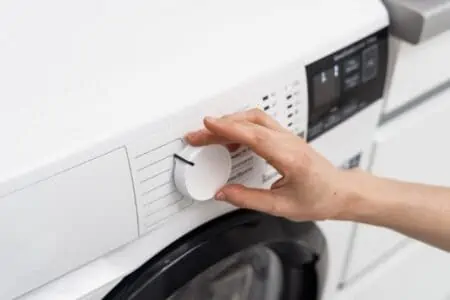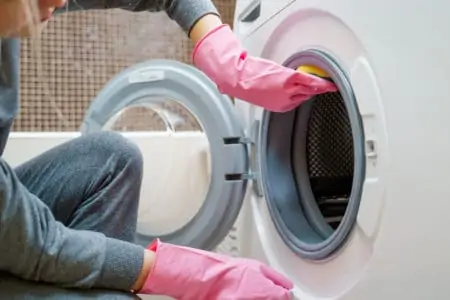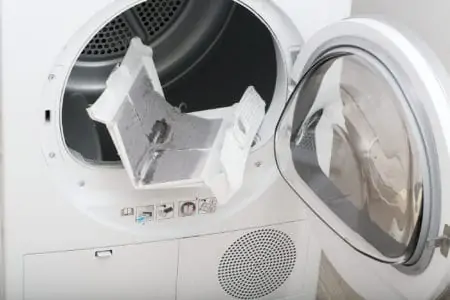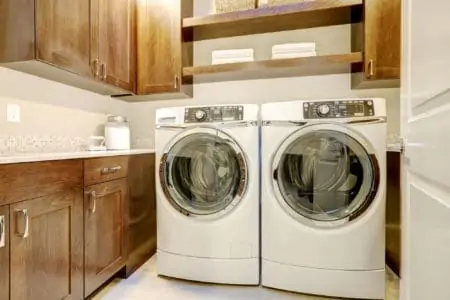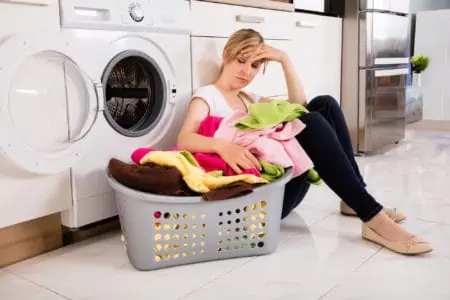We’ve been the proud owners of a Samsung washing machine for many years — it’s our favorite brand. One of the best things about it is that even when something goes wrong, it tells you exactly what the problem is.
Samsung uses codes to alert you to an issue. However, the screen doesn’t display the solution. That’s where we come in.
We’ll share the best methods for Samsung washing machine troubleshooting, what the errors mean and how to fix them. These apply to both top loader and front loader Samsung machines.
Key Takeaways
- Samsung washing machines use error codes to indicate issues, such as water not draining or unbalanced loads.
- Common problems include the washer not starting, not spinning, stopping mid-cycle, and door lock issues.
- To fix issues, check for power, door latch, unbalanced loads, or follow the specific error code’s instructions.
- Resetting a Samsung washing machine involves unplugging it for five minutes and then turning it back on.
Samsung Washing Machine Troubleshooting
Below is a table of the common Samsung error symbols and their meaning.
| Error Code | What It Means |
| 1E, LE, 1C, LC, LC1, 1 1C, 1 LC | Moisture detected where it doesn’t belong, water level error, or leakage error — or there is an issue with the water sensor. |
| N4, 4C2, 4E2, CE, 14C2 | The water from the cold supply is hot; the supply hoses are swapped. |
| nd, 5E, SE, 5C, SC, 1 5C | The washing machine isn’t draining water. |
| OE, 0E, OC, 0C, 1 OC, 1 0C | There is too much water in the machine, or water is overflowing. |
| E2, bE2, 6E2, BE2, 8E2 | A button on the panel is stuck. |
| 9C1, 9C2, PF, 3E, 2E, 9E1, 9E2, UC, 19C1, 19C2 | There is a voltage error in the electrical current supplied to the machine. |
| dS, d5, FL, LO, L0, dE, dE1, dE2, dC, dC1, dL, 1 dC, 1dC4, 1dC1 | The door isn’t closed and locked. |
| SDC, 5DC, SUd | The detergent drawer isn’t completely closed. |
| SUd, 5UD, Sd, 5d, SUdS, 5Ud5 | The washing machine is over-sudsing. |
| ddC, dC3 | The Add Door isn’t closed and locked. |
| dc, Ub, U6, Ur, UE, 1 Ub, 1U6 | The load is unbalanced. |
| Cb, C6 | The machine is in calibration mode to try and recalibrate the weight detection. |
| CL | The machine is draining water from the tub since child lock mode is on, but the door is open, and the water level is unsafe. |
| dn | The machine is downloading an update. |
| Refill detergent or softener | The auto dispenser is empty — you need to refill it. |
| H1, H2, HE, HE1, HE2, HC, HC1, HC2, E5, E6 | The water is heated too slowly, not at all, or overheated. |
| 4E, 4C, E1 | The water isn’t filling the drum when it’s supposed to. |
| bE, 6E, bE1, bE2, bE3, bC, bC2, b2, Eb | The machine won’t start. |
| tE, tE1, tE2, tE3, tC, tC1, tC2, tC3, tC4, Ec | There is no signal from the temperature sensor to the controller. |
| AE, AC, ACb, AC6, 13E | There is an error in exchanging data between the display board and the control module. |
| 8E, 8E1, 8C, 8C1 | There is a problem with the engine, tacho sensor, or vibration sensor. |
| PoF, PF | The power was disconnected during the washing cycle. |
Common Samsung Washing Machine Problems and Solutions
Now that you know some Samsung washing machine problems, it’s time to learn how to fix them. We’ll guide you through common issues, what’s causing them and how to resolve them.
Washer Not Starting
- Caused by: No electricity, the machine won’t turn on, the door isn’t locked, or there is an electrical problem.
- How to fix it: Start by ensuring there’s power to the machine. Then clean the contact points on the door’s latch using rubbing alcohol and a cotton swab. Ensure that the door shuts and locks. If that doesn’t work, put the machine into diagnostic mode (check your user manual for instructions) to determine the mechanical problem.
Washer Won’t Spin
- Caused by: An unbalanced load, either from clothes or inadequate water.
- How to fix it: The machine will try to add more water to rebalance the load. This will add time to the cycle. If you need to fix it manually, redistribute the clothes and ensure the machine isn’t overloaded.
Professional Help
If you don’t overload the machine, but it only happens when doing larger loads, there might be a control board issue. You will need to get a technician to repair it. Check if your Samsung machine is still covered by warranty.
Washer Stops Mid-Cycle
- Caused by: Almost any error can stop your machine in the middle of the cycle.
- How to fix it: Read the error code on the screen. If there isn’t one, run a diagnostic test to see if there is an error. Manually drain the machine if necessary. Reload the machine but don’t overload it.
Washer Trips Electrical Circuit
- Caused by: Water leakage onto the machine’s electrical element or a voltage error.
- How to fix it: Turn off and unplug your washing machine. Check if your model has been recalled. Call Samsung support for further advice. If it’s not due to water leakage, check that your machine is on its own circuit and not using an extension cord.
Door Lock Issues
- Caused by: Something prevents the door from locking.
- How to fix it: Check that the latch isn’t broken. Check that there isn’t anything caught in the door. Close the door properly — you might need to slam it! Clean the latch with rubbing alcohol and a cotton swab.
Don’t Forget
If the door is locked and you can’t open it, check if you have the Child Lock on.
Washer Won’t Drain
- Caused by: A clog in the machine.
- How to fix it: You must drain the washing machine manually. Turn the machine off and open the filter cover at the bottom of the machine. Place towels and a tray beneath the plug, then unscrew the emergency drain cap. Let the water drain out. Then pull the emergency drain tube out before removing the cap. Let all the water drain into a tray or bowl. Insert the drain tube back in and put the cap on the emergency drain. Restart the cycle.
Water Overflow
- Caused by: Too much water in the machine.
- How to fix it: Replace the water inlet valve assembly. You should also follow the above instructions to check for clogs. Make sure you’re using the right detergent for your machine.
On this note, we had this issue before, and it turned out that something sharp had ripped the rubber seal on the machine. The water flowed out of the machine, but the cycle continued.
In the end, Samsung sent somebody to replace the rubber seal for free since the machine was under warranty.
Keep in mind that some Samsung machines, like Aquajet, use high blasts of power. Because of this extra momentum, it’s crucial you don’t overload your machine as this could cause overflow.
Water Fills Slowly or Not At All
- Caused by: The water supply faucets aren’t fully open or kink-free. The washing machine lines are frozen. The inlet valves are defective.
- How to fix it: Ensure the supply faucets are open and not kinked. If the lines are frozen, ensure that they defrost correctly. If the inlet valves are faulty, replace them.
Washer Leaks During Rinse Cycle
- Caused by: A hole in the interior lining of the machine (such as the drain hose or the black bellows hose).
- How to fix it: You will need to repair or replace the punctured element. Also, check that you are using the right amount and kind of detergent. Clean the washing machine and make sure it is level. Ensure that the drain hose is correctly installed. Run a test cycle.
Washer is Noisy
- Caused by: The load is unbalanced, the machine isn’t level, or the shipping bolts are still in.
- How to fix it: Rebalance the load and use a spirit level to ensure the machine is level. Make sure to remove the shipping bolts before using the machine.
Samsung washing machines are really quiet. That’s one thing we love most about them. Many models use VRT technology which runs even more quietly — you can even run the machine near your children’s bedrooms!
Water Won’t Heat Up
- Caused by: There is an issue with the temperature sensor, or the fill hoses aren’t correctly installed at the back.
- How to fix it: Check your inlet hoses are attached correctly. If it’s an issue with the temperature sensor, you will need to have it replaced.
Bleach Spotting or Detergent Streaks On Fabric
- Caused by: Too much detergent is used, the machine is unbalanced, or there are water level issues.
- How to fix it: Don’t overfill the detergent dispenser or use too much detergent. Make sure the washing machine is leveled. Otherwise, it will dispense bleach at the wrong time. Deep clean the machine, and run a new cycle.
Control Panel Won’t Respond
- Caused by: A jammed button or the machine is downloading an update. Or there could be an electrical issue.
- How to fix it: If it’s a jammed button, turn the machine off and individually touch every button, moving it back and forth to reach all edges. And if that doesn’t work, contact Samsung. If the machine is downloading an update, keep the machine on and wait until it’s done updating. Contact Samsung if it’s an electrical issue, as you might need the control panel replaced.
Water Pooling In Detergent Tray
- Caused by: The water that flushes through the tray isn’t cut off quickly enough.
- How to fix it: As long as the water is clear, there’s no need to fix it. However, if the detergent residue is also in the tray, clean it regularly and replace the faulty solenoid if necessary.
How to Reset a Samsung Washing Machine
Sometimes, a reset is part of the troubleshooting process. To do this, unplug the machine and wait five minutes for the electrical charge to clear from the machine. Then turn it on again.
Be aware that it’s not always a good idea to reset your machine. When you do this, the machine will clear out all the fault codes, but it won’t fix the error. In fact, repeatedly doing this makes it harder for a technician to diagnose and fix the issue.
On newer models, you can restore the machine to factory settings. Go to the main menu and press the finger button, holding it down until system functions show up. Browse to factory reset and confirm it.
FAQs
Fixing All Kinds of Issues
Now that you’re an expert in Samsung washer troubleshooting, these error icons won’t freak you out! Samsung makes diagnosing issues easy and provides straightforward solutions to fix the problems yourself.
Always make sure to contact Samsung if you’re struggling to fix your machine. You can’t resolve some of the problems on your own. Thankfully, Samsung offers a great warranty, so you shouldn’t have to pay for repairs out of your own pocket.
